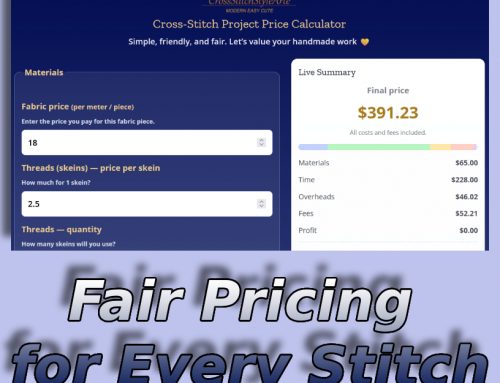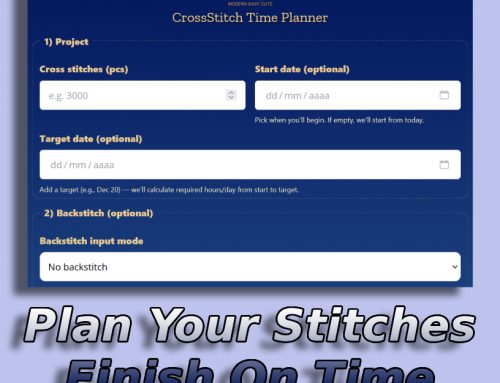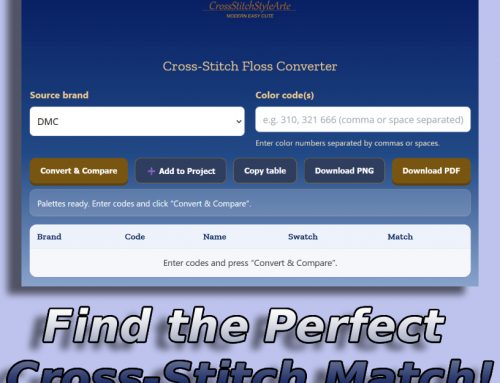Cross-Stitching on Different Fabric Types: What You Need to Know
Choosing the right fabric is crucial for any cross-stitch project. The type of fabric you select will affect not only the look of your finished piece but also your stitching experience. In this blog, we’ll explore the most popular fabric types used in cross-stitching, discuss their unique characteristics, and provide tips for selecting the best fabric for your project.
1. Aida Fabric: The Most Popular Choice for Beginners
Aida fabric is the most commonly used fabric in cross-stitching, especially for beginners. It’s a woven fabric that comes in various “counts,” which refers to the number of threads per inch. The most common Aida fabrics are 14-count and 16-count, meaning there are 14 or 16 squares per inch, respectively.
Key Features:
– Easy to Use: Aida’s grid-like structure makes it easy to see where to place your stitches, which is why it’s often recommended for beginners.
– Versatility: It comes in different counts, making it suitable for a variety of designs, from simple to complex.
– Wide Availability: Aida is widely available in craft stores and online, with a range of colors to choose from.
Tips for Stitching on Aida:
– Start with a 14-count: If you’re new to cross-stitching, a 14-count Aida is ideal as it offers a good balance between stitch size and detail.
– Use a hoop: Aida fabric tends to be stiff, but using a hoop can help keep your fabric taut and your stitches even.
2. Evenweave Fabric: For More Detailed Work
Evenweave fabric is another popular choice, especially among more experienced stitchers. Unlike Aida, which has visible blocks, Evenweave has a smooth, even texture, making it ideal for more detailed and intricate designs. It usually comes in 25 to 32-count, meaning you get finer, more detailed stitches.
Key Features:
– Smooth Texture: Evenweave has a finer texture than Aida, allowing for more intricate designs and details.
– Flexibility: You can stitch over one or two threads, giving you more control over the final look of your project.
– Variety: Available in various colors and counts, Evenweave allows for more creative freedom.
Tips for Stitching on Evenweave:
– Practice: If you’re used to Aida, Evenweave can take some getting used to, as the stitches are smaller and less defined.
– Use Good Lighting: The finer weave can be harder to see, so good lighting and possibly a magnifier can be helpful.
3. Linen Fabric: A Classic Choice for Advanced Stitchers
Linen fabric is known for its luxurious feel and is often used for high-end or heirloom-quality projects. It’s a natural fiber with a slubby texture, which gives it a unique look. Linen is typically used by more experienced stitchers due to its less uniform weave and higher thread count.
Key Features:
– Natural Look: Linen has an organic, rustic appearance, making it perfect for traditional or vintage-style projects.
– Durability: Linen is strong and durable, ensuring your projects will stand the test of time.
– High Thread Count: Typically ranging from 28 to 40-count, linen allows for very fine and detailed stitching.
Tips for Stitching on Linen:
– Count Carefully: Linen’s uneven weave requires careful counting, especially for more complex patterns.
– Use Even Tension: Keeping an even tension is crucial on linen to avoid distorting the fabric.
4. Waste Canvas: For Custom Designs on Clothing and Home Decor
Waste canvas is a special type of fabric that allows you to stitch on non-traditional surfaces, such as clothing or home decor items. It’s a temporary canvas that is removed after stitching, leaving your design neatly embroidered on the fabric beneath.
Key Features:
– Versatile Use: Waste canvas is perfect for adding cross-stitch designs to clothing, tote bags, pillows, and more.
– Easy Removal: After stitching, the waste canvas threads can be easily pulled out, leaving your stitches intact on the fabric.
Tips for Stitching on Waste Canvas:
– Secure the Canvas: Use pins or basting stitches to hold the waste canvas in place on your fabric.
– Remove Carefully: When removing the canvas, do so gently to avoid pulling or distorting your stitches.
5. Perforated Paper: A Unique Option for Small Projects
Perforated paper is a fun and unique option, often used for small projects like ornaments, bookmarks, or greeting cards. It’s a stiff paper with holes punched in it, similar to fabric but more rigid, which makes it easy to handle without a hoop.
Key Features:
– Easy to Use: No hoop is required, and the stiffness of the paper makes it easy to hold and stitch.
– Ideal for Gifts: Perforated paper is perfect for creating handmade gifts and decorations.
– Limited Durability: It’s not as durable as fabric, so it’s best for projects that won’t undergo heavy use.
Tips for Stitching on Perforated Paper:
– Handle with Care: Perforated paper can tear if handled roughly, so be gentle when stitching and finishing.
– Finish the Edges: Consider finishing the edges with a backstitch or border to prevent fraying.
Conclusion: Choosing the Right Fabric for Your Project
Selecting the right fabric for your cross-stitch project depends on your skill level, the complexity of your design, and the look you want to achieve. Whether you prefer the simplicity of Aida, the detail of Evenweave, the elegance of Linen, or the versatility of Waste Canvas and Perforated Paper, understanding the characteristics of each fabric type will help you make an informed decision and ensure a beautiful finished piece.
Here you can find other cross-stitch tutorials and masterclasses for beginners and beyond.
























Leave A Comment